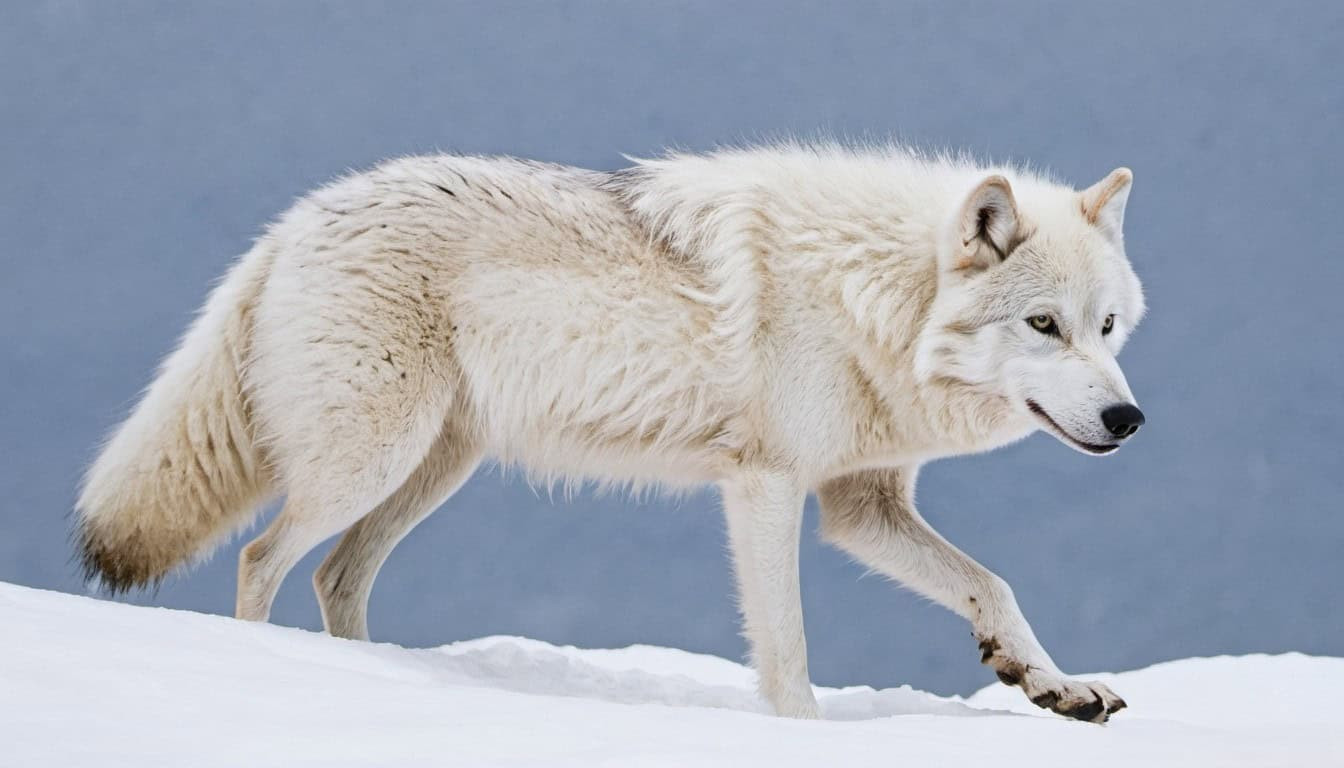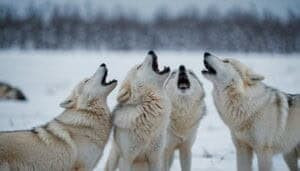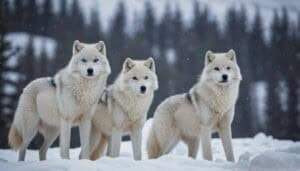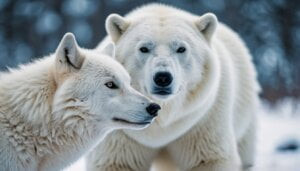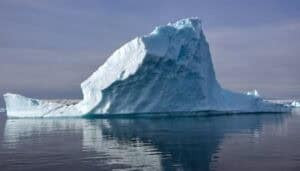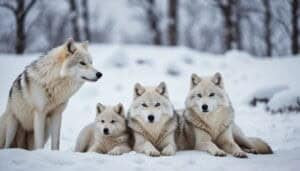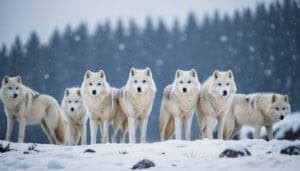Introduction
Arctic wolves, also known as white wolves, are fascinating creatures uniquely adapted to the extreme cold of their native Arctic environments. This article explores the various physiological and behavioral adaptations that enable these resilient animals to survive and thrive in temperatures that would be unbearable for many other species
From their thick, insulating fur to their specially adapted paws and efficient metabolic systems, Arctic wolves have evolved a suite of traits that allow them to maintain their body heat, hunt effectively, and care for their young in one of the harshest climates on Earth
Fur and Insulation
Arctic wolves possess several unique adaptations that enable them to survive in the frigid temperatures of the Arctic
One of the most critical adaptations is their fur, which plays a crucial role in insulation and protection against the cold. The Arctic wolf’s fur is specially designed to retain body heat and provide a barrier against the icy winds and snow
Importance of Thick Fur
The thick fur of the Arctic wolf is essential for its survival in sub-zero temperatures. This fur consists of two layers: an undercoat and an outer coat. The undercoat is dense and woolly, providing excellent insulation by trapping heat close to the body
This layer is particularly important during the coldest months of winter when temperatures can plummet dramatically. The outer coat, on the other hand, is composed of longer, guard hairs that are water-resistant, preventing the inner layer from becoming wet from snow and ice. This dual-layered fur system ensures that Arctic wolves remain warm and dry even in the most challenging weather conditions
Double-Layered Coat
The double-layered coat of the Arctic wolf is a marvel of natural engineering. The undercoat is made up of short, fine hairs that are incredibly dense, creating a thick insulating layer. This layer acts as a thermal barrier, trapping the wolf’s body heat and preventing it from escaping into the cold air
The outer coat, with its longer and coarser hairs, provides additional protection by repelling water and blocking wind. This combination of layers makes the fur not only warm but also incredibly effective at keeping the wolf dry, which is vital for maintaining body heat in the Arctic’s freezing environment
Seasonal Fur Changes
Arctic wolves also undergo seasonal changes in their fur to adapt to varying temperatures throughout the year. During the winter, their fur becomes thicker and more insulating, providing maximum protection against the cold
In contrast, during the summer months, Arctic wolves shed much of their heavy winter coat, replacing it with a lighter, less dense fur. This seasonal molting process helps them stay cool during the relatively warmer summer while still providing sufficient insulation against the chill of Arctic nights. This adaptability in their fur density is crucial for the Arctic wolf’s year-round survival in an environment with extreme seasonal temperature fluctuations
Arctic wolves have evolved a sophisticated fur system that plays a pivotal role in their ability to withstand the harsh conditions of their habitat. The combination of a dense undercoat and a water-resistant outer coat, along with the ability to adjust their fur density seasonally, enables these wolves to maintain their body heat and thrive in one of the planet’s most unforgiving climates
Paws and Locomotion
Arctic wolves have adapted remarkably well to the challenging terrain and extreme cold of their environment. Their paws are specifically designed to support efficient locomotion on snow and ice, playing a crucial role in their survival
Structure of Paws
The paws of Arctic wolves are uniquely structured to provide stability and traction in snowy and icy conditions. They are larger and more robust than those of other wolf species, distributing the wolf’s weight more evenly across the snow
This prevents them from sinking into soft snow, enabling them to move swiftly and efficiently. Additionally, the pads of their paws are covered in a thick layer of fat and connective tissue, which serves as insulation against the cold ground. This fatty layer helps keep the paws warm, reducing the risk of frostbite and other cold-related injuries
Walking on Snow
Arctic wolves possess several features that aid in their ability to walk on snow. Their large, wide paws act like natural snowshoes, spreading their weight and providing better traction on soft and powdery surfaces
This adaptation allows them to traverse vast expanses of snow without expending excessive energy. The fur between their toes also plays a vital role in insulation and preventing snow from accumulating between their paw pads. This fur helps maintain their body heat and keeps their paws dry, ensuring they can move comfortably even in deep snow
Heat Retention in Paws
One of the most critical adaptations for Arctic wolves is their ability to retain heat in their paws. The blood vessels in their paws are arranged in a unique countercurrent heat exchange system. This system works by allowing warm blood flowing from the body core to heat the colder blood returning from the paws
As a result, the temperature of the blood in the paws remains relatively stable, preventing heat loss and protecting the wolf from frostbite. This efficient heat exchange mechanism is essential for maintaining the wolf’s overall body temperature and ensuring its survival in extremely low temperatures
The paws of Arctic wolves are a testament to their evolutionary ingenuity, equipped with features that allow them to navigate and thrive in their icy habitat. From their large size and insulating structures to their unique heat retention mechanisms, these adaptations ensure that Arctic wolves can move efficiently and remain warm, no matter how harsh the conditions
Body Heat Maintenance
Arctic wolves have developed several physiological adaptations that allow them to maintain their body heat in the frigid Arctic environment. These adaptations include adjustments in their metabolic rate, a compact body shape, and small ear size, all of which play crucial roles in their survival
Metabolic Rate Adjustments
Arctic wolves have a higher basal metabolic rate compared to wolves living in milder climates. This increased metabolic rate generates more body heat, which is essential for maintaining a stable internal temperature in extremely cold conditions
The metabolic rate is the speed at which an animal’s body converts food into energy. In Arctic wolves, this process is highly efficient, allowing them to produce sufficient heat to keep their bodies warm. Additionally, their bodies can adjust this metabolic rate based on the severity of the cold, ensuring they can conserve energy when temperatures are more manageable and ramp up heat production during extreme cold spells
Compact Body Shape
The body shape of the Arctic wolf is another significant adaptation for heat conservation. They have a more compact body compared to other wolf species, which reduces the surface area exposed to the cold
This compact shape minimizes heat loss by limiting the amount of skin that comes into contact with the cold air. A smaller surface area to volume ratio means that there is less area through which heat can escape, helping the wolves retain their body heat more effectively
Furthermore, their shorter limbs and tails also contribute to this reduced surface area, enhancing their ability to conserve warmth
Small Ear Size
The small ear size of Arctic wolves is a vital adaptation for minimizing heat loss. In cold environments, extremities like ears can be significant sources of heat loss because they have a large surface area relative to their volume
By having smaller ears, Arctic wolves reduce the amount of exposed surface area, thus decreasing the potential for heat loss. Additionally, the blood vessels in their ears can constrict to reduce blood flow to these extremities during extreme cold, further conserving body heat
This adaptation is crucial for maintaining overall body temperature and preventing frostbite on the ears, which are particularly vulnerable to cold injury
Arctic wolves have evolved a suite of physiological traits that enable them to maintain their body heat in one of the harshest climates on Earth. Their ability to adjust metabolic rates, combined with their compact body shape and small ears, allows them to conserve warmth and thrive in their icy habitats. These adaptations are essential for their survival, ensuring that they can withstand the extreme temperatures of the Arctic environment
Behavioral Adaptations
In addition to their physiological adaptations, Arctic wolves exhibit a range of behavioral strategies that enable them to survive and thrive in the harsh Arctic environment. These behaviors include specific hunting strategies, den building, and pack dynamics, all of which play crucial roles in their ability to endure extreme cold and find food
Hunting Strategies
Arctic wolves have developed effective hunting strategies that are essential for their survival in a habitat where food is often scarce. They primarily hunt in packs, which allows them to take down larger prey such as muskoxen and caribou that would be difficult to capture alone
By working together, they increase their chances of a successful hunt, ensuring that all members of the pack have enough food to sustain them through the harsh conditions. Additionally, Arctic wolves have adapted to the seasonal availability of prey
During the summer, when prey is more abundant, they may hunt smaller animals and store fat for the winter months. In winter, when prey is harder to find, they rely more heavily on their stored fat reserves and the efficiency of their pack hunting techniques
Den Building
Den building is another critical behavioral adaptation of Arctic wolves. They create dens in sheltered areas such as caves, rock crevices, or dug-out burrows to protect themselves and their young from the extreme cold and harsh winds. These dens are often lined with insulating materials like fur and feathers to provide additional warmth
By retreating to these dens, Arctic wolves can conserve body heat and shield themselves from the elements. During the breeding season, dens also provide a safe and warm environment for raising pups, who are particularly vulnerable to the cold. The strategic location and construction of these dens are vital for the survival of both adult wolves and their offspring
Pack Dynamics
The social structure and dynamics of the Arctic wolf pack play a significant role in their survival. Living and hunting in packs provide several advantages, including increased protection from predators, more efficient hunting, and better care for the young
Pack members cooperate in various activities, from hunting to raising pups, ensuring that all individuals contribute to the group’s overall well-being. The alpha pair typically leads the pack, making crucial decisions about hunting routes and den sites. This hierarchical structure helps maintain order and coordination within the pack, enhancing their ability to adapt to the challenging Arctic environment
Additionally, the close-knit bonds between pack members provide emotional support and social stability, which are important for coping with the stresses of their harsh habitat
The behavioral adaptations of Arctic wolves, including their hunting strategies, den building, and pack dynamics, are integral to their survival in the extreme conditions of the Arctic. These behaviors not only help them find food and stay warm but also ensure the cohesion and success of the pack as a whole
Through cooperation and strategic behavior, Arctic wolves can navigate the challenges of their environment and continue to thrive in one of the most inhospitable places on Earth
Diet and Metabolism
The Arctic wolf’s diet and metabolic adaptations are crucial for its survival in the extreme cold. These wolves have evolved to consume a high-calorie diet and possess efficient metabolic processes that allow them to generate and conserve energy effectively
High-Calorie Diet
Arctic wolves primarily feed on large herbivores such as muskoxen, caribou, and Arctic hares. These prey animals provide a high-calorie diet, which is essential for maintaining body heat and energy levels in the frigid Arctic environment
The high fat and protein content of their prey help the wolves to build and store fat reserves, which are crucial during times when food is scarce. This high-calorie diet not only supports their daily energy needs but also allows them to endure the long, harsh winters when hunting opportunities are limited
Seasonal Feeding Habits
Arctic wolves adapt their feeding habits according to the seasons. In the summer, when prey is more abundant, they consume large quantities of food to build up fat reserves for the winter. This period of abundance allows them to eat to their fill and gain the necessary weight to survive the colder months
During winter, food becomes scarcer, and Arctic wolves rely more on their fat reserves. Their ability to gorge and store fat during the summer months is a critical survival strategy that enables them to withstand periods of food scarcity in winter. Additionally, they may scavenge carcasses left by other predators or hunt smaller animals to supplement their diet
Metabolic Efficiency
The metabolic efficiency of Arctic wolves is another key adaptation for surviving in the cold. Their bodies are highly efficient at converting food into energy and maintaining body heat. The process of thermogenesis, where the body generates heat from food metabolism, is particularly pronounced in Arctic wolves. This ability to produce heat from their food intake helps them to stay warm in extremely low temperatures
Furthermore, their metabolism can adjust to conserve energy during periods of food scarcity, reducing the rate at which they burn calories and extending the duration of their fat reserves
Arctic wolves also have a lower basal metabolic rate compared to other canids, which helps them conserve energy when resting. This adaptation is especially useful during the long Arctic nights when temperatures drop significantly, and conserving energy becomes crucial for survival. By lowering their metabolic rate, they reduce their overall energy expenditure, allowing them to survive longer without food
The diet and metabolic adaptations of Arctic wolves are integral to their ability to survive in the harsh Arctic environment. Their high-calorie diet, seasonal feeding habits, and metabolic efficiency ensure that they have the necessary energy to endure the extreme cold and periods of food scarcity. These adaptations highlight the remarkable resilience and ingenuity of Arctic wolves in thriving in one of the most challenging habitats on Earth
Reproductive Strategies
Arctic wolves have developed unique reproductive strategies that enable them to successfully raise offspring in the extreme conditions of the Arctic. These strategies include the timing of reproduction, care for offspring, and adaptations to the harsh climate that impact their breeding practices
Timing of Reproduction
Arctic wolves time their reproductive cycle to ensure that pups are born during the warmer months of the year. Mating typically occurs in late winter, with pups being born after a gestation period of about 63 days, usually in April or May
This timing is crucial because it allows the pups to be born when temperatures are rising and food is becoming more plentiful. By giving birth in the spring, Arctic wolves ensure that their pups have a better chance of survival, as they will grow stronger during the milder summer months before facing their first winter
Care for Offspring
The care and nurturing of offspring are vital aspects of the Arctic wolf’s reproductive strategy. After birth, the mother stays with the pups in a den, which provides protection from the cold and predators
The dens are typically located in sheltered areas, such as caves, rocky crevices, or burrows dug into the ground. These locations offer additional warmth and security for the vulnerable pups. Both parents and other pack members play a role in feeding and protecting the young
The pack’s cooperative behavior ensures that the pups receive sufficient food and care, enhancing their chances of survival
The mother nurses the pups for the first few weeks, providing them with essential nutrients and antibodies through her milk. As the pups grow, they gradually transition to solid food, which is often regurgitated by the adults
This process allows the pups to adapt to their carnivorous diet and learn hunting skills from an early age. The extended care period, combined with the support of the pack, is crucial for the pups’ development and integration into the pack’s social structure
Impact of Climate on Breeding
The harsh Arctic climate significantly impacts the breeding practices of Arctic wolves. The extreme cold and scarcity of food during winter pose challenges for raising young. Therefore, the timing of reproduction and the choice of den sites are critical for the survival of the pups
Arctic wolves tend to choose den sites that offer maximum protection from the elements, such as those with good insulation and shelter from the wind. Additionally, they may relocate the pups to different dens if the original site becomes unsafe or if food availability changes
The reproductive success of Arctic wolves is closely tied to the availability of prey. In years when prey is abundant, more pups are likely to survive and thrive. Conversely, during years of prey scarcity, the survival rate of pups may decrease. This variability in reproductive success is a natural adaptation to the fluctuating conditions of the Arctic environment
By synchronizing their reproductive efforts with periods of higher prey availability, Arctic wolves increase the likelihood that their offspring will survive to adulthood
The reproductive strategies of Arctic wolves are finely tuned to the demands of their environment. By timing their reproduction, providing extensive care for their offspring, and adapting to the harsh climate, these wolves ensure the continuation of their species in one of the most challenging habitats on Earth. These strategies highlight the remarkable resilience and adaptability of Arctic wolves in the face of extreme environmental pressures
Conclusion
Arctic wolves possess an array of physiological and behavioral adaptations that enable them to thrive in the extreme cold of their native habitats. Their thick, insulating fur and uniquely structured paws provide essential protection and mobility in snowy and icy conditions
Efficient metabolic processes and compact body shapes help maintain their body heat, while their small ears minimize heat loss. Additionally, Arctic wolves exhibit strategic behaviors, such as pack hunting, den building, and cooperative care of offspring, which are critical for their survival
Their diet and reproductive strategies further support their ability to endure the harsh Arctic climate. Through these combined adaptations, Arctic wolves demonstrate remarkable resilience and ingenuity, ensuring their survival in one of the most inhospitable environments on Earth
